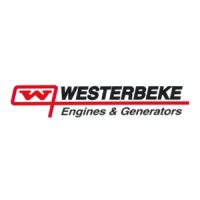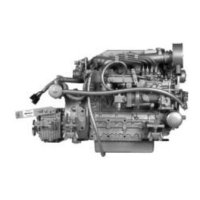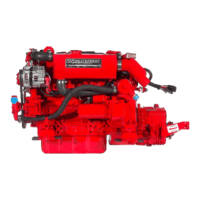)
COOUNG
SYSTEM
Description
Westerbeke
marine diesel engines
are
designed
and
equipped for fresh water cooling. Heat produced
in
the
engine
by combustion and friction
is
transferred
to fresh water which circulates throughout the
engine.
This circulating fresh water cools the engine block
and
Its
internal moving parts.
The
heat
is
transferred
ex-
ternally from the
fresh
water to
sea
water by
means
of
a heat exchanger,
simOar
in
function to
an
automo-
tive radiator.
Sea
water flows through the tubes of the
heat
exchanger
whOe
fresh
water flows around the
tubes; engine
heat transferred
to
the fresh water
is
conducted through the tube walls to the
sea
water which
is then pumped into the exhaust
system where finally it is discharged overboard.
In
other words, the
engine
is
cooled by fresh water,
the
fresh water
is
cooled
by
sea
water,
and the sea water
canries
the transferred
heat over the side through
the
exhaust
system.
The
fresh
water and sea water circuits are independent of
each
other.
Using only fresh water within the
engine
allows the cooling water passages
to
stay clean
and
free from harmful deposits. The
two
independent circuits
and
their components
are
discussed
in
the
follow-
ing paragraphs.
Fresh Water Circuit
NOTE:
Referto paragraphs A and B
in
this section
on
the recommended antifreeze
and
water
mixture to be used as the fresh water coolant.
and
for infonnation
on
filling the fresh water
system.
Fresh
water
Is
pumped through
the
engine by a
beIt-driven
circulating pump, absorbing heat from the en-
gine.
The
fresh water coolant circulates through
the
engine's block absorbing
heat,
then passes through
the
thermostat into the exhaust manifold, to the
heat
exchanger where it
is
cooled, and then
is
returned to
the
engine
block through the suction side of the
fresh
water circulating pump.
When
the engine is started
cold, external
fresh water flow
Is
prevented by the closed thennostat (although some fresh water flow
is
bypassed around the thermostat to prevent
exhaust
manifold from overheating).
As
the engine wanns up,
the thermostat gradually opens, allowing full flow
of
the engine's fresh water coolant to flow unrestricted to
the
extemaJ
portion of the cooling system.
A.
Fresh
Water Coolant (Antifreeze) Mixture.
A freshwater and antifreeze mixture should
be
used
year-round.
Water,
when
it
freezes,
expands sufficient-
ly to split the heat exchanger and crack the engine block. A water/antifreeze mixture of proper concentra·
tion
will
prevent freezing.
Use
soft water with few impurities, such
as
tap water (potable water) or
rainwater.
Never
use
hard or
foul
water.
Use
of hard water or water containing impurities
wIll
lead
to the collection
of
scale
in
the engine
and
heat
exchanger which
wJli
reduce the cooling system's efficiency.
Antifreeze
of poor quality or without rust inhibitors
will
cause
corrosion within the cooling system.
Always
use
antifreeze which
is
compatible with
aluminum
cooling system components
and
is
made by a reliable
manufacturer.
Never mix different brands
of
antifreeze.
Make
sure
the engine's cooling system
is
well
cleaned
before adding antifreeze. Recommended antifreeze
for
year
round use
is
ZEREX
or
PRESTONE
with
rust
inhibitors.
In
order to control the concentration
of
the mixture,
mix
the antifreeze
and
freshwater thoroughly before ad·
ding it to the cooling system.
Engines & Generators
31
